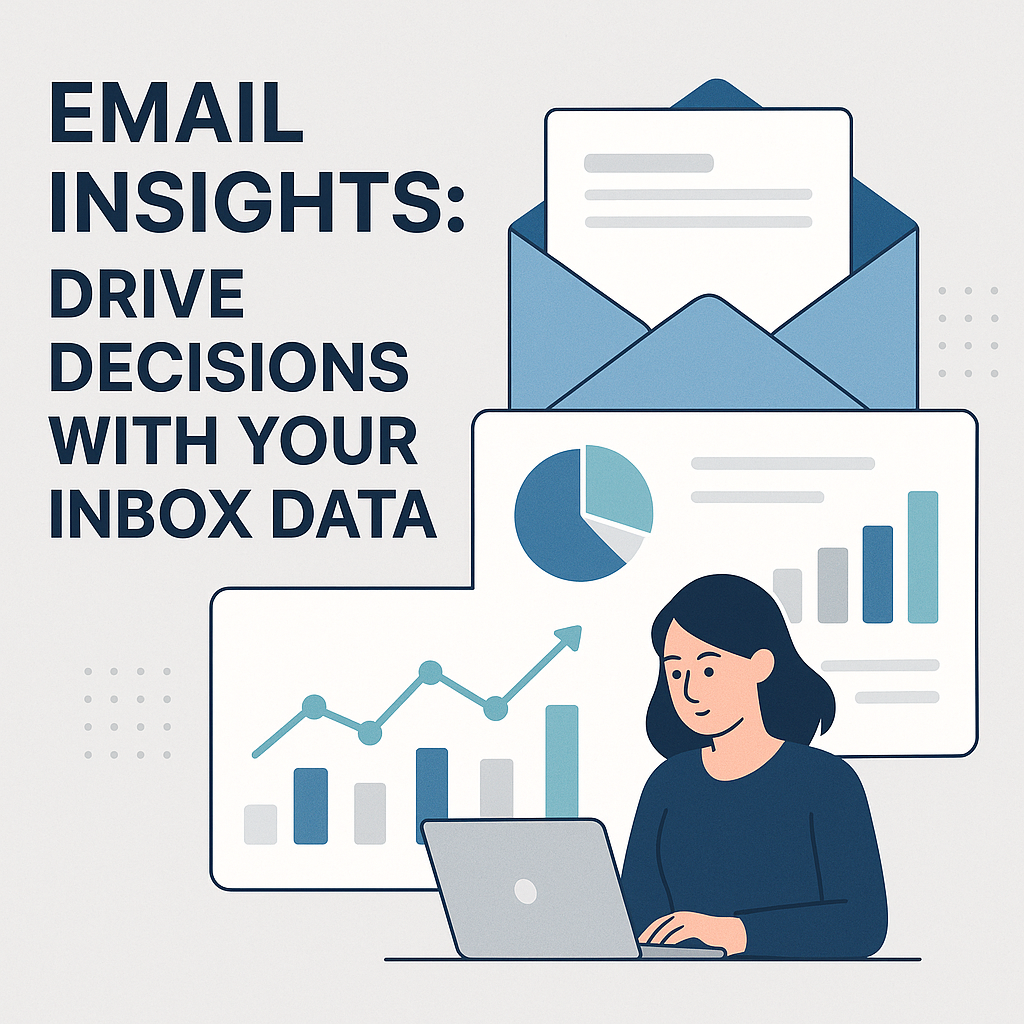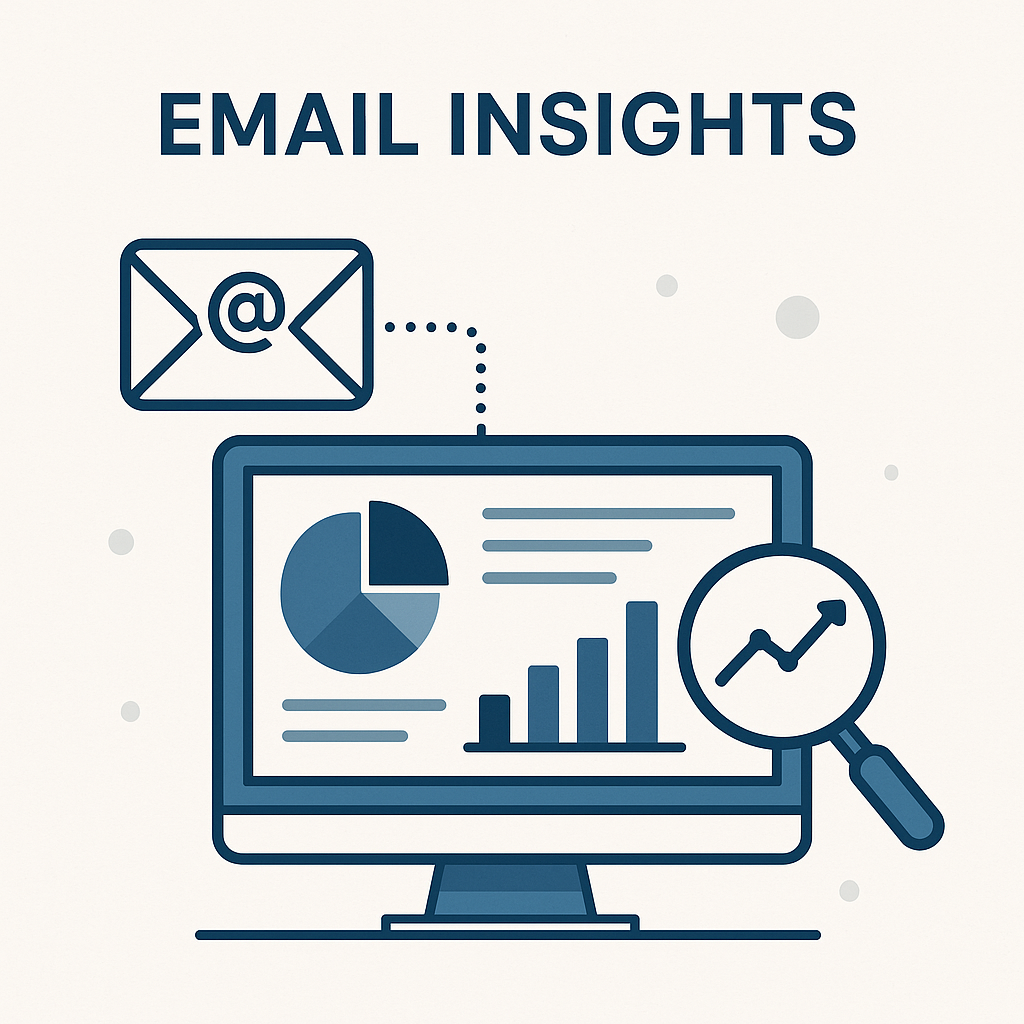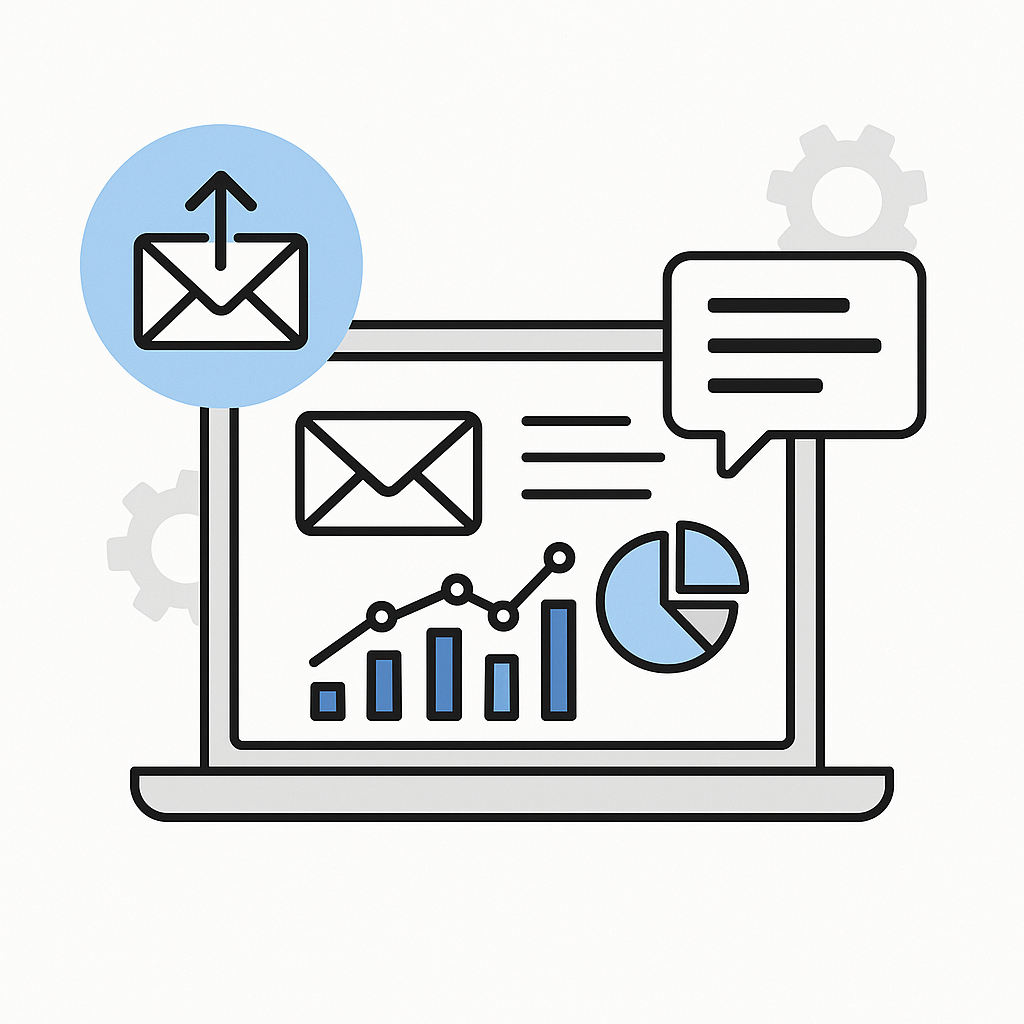Email Insights: Drive Decisions with Your Inbox Data

In today's hyper-connected business world, your inbox is more than just a digital mailbox; it's a bustling hub of communication, a repository of decisions, and a goldmine of untapped business intelligence. For busy professionals, entrepreneurs, and teams drowning in a daily deluge of messages, the sheer volume can be overwhelming. However, buried within that endless stream of emails lies the potential to unlock powerful email insights that can drive smarter decisions, boost productivity, and transform how you operate. This article delves into the strategic value of your inbox data, guiding you on how to move beyond simple inbox management towards a data-driven approach to understanding and optimizing your business communication.
Understanding the Value of Email Data Beyond the Inbox
Think about your inbox. It's where deals are negotiated, problems are solved, teams collaborate, and customers are engaged. Each email exchanged is a data point, a record of an interaction, a sentiment expressed, or a decision made. When aggregated and analyzed, this data offers a unique lens into the pulse of your business. It's not just about what's being said, but also about how, when, and with whom communication is happening.
Leveraging email analytics allows you to:
- Gauge Collaboration Patterns: Understand how teams or individuals interact, identify communication bottlenecks, and pinpoint areas where collaboration could be improved. For example, seeing that certain critical projects consistently face delays due to slow email responses can highlight a process issue.
- Monitor Customer Engagement: While often associated with marketing emails, the frequency and nature of client communication in your daily inbox can also reveal engagement levels and potential churn indicators.
- Identify Knowledge Gaps: Recurring questions or misunderstandings in email threads can signal a need for better internal documentation or training.
- Track Decision-Making Velocity: Analyze response times and the flow of information to understand how quickly decisions are being made and where delays occur.
- Optimize Workflow Efficiency: Discover which communication channels are most effective for different types of tasks and identify redundant or time-consuming email practices.
By treating your inbox as a rich data source, you can move towards genuine data-driven decision making, transforming raw communication into strategic intelligence. This shift is fundamental for leadership aiming to enhance overall business performance and foster a more efficient work environment. As highlighted in articles discussing AI Business Strategy, leveraging data from all business functions, including communication, is key to staying competitive.
Identifying Key Metrics for Email Insights
To extract meaningful intelligence, you need to know what to measure. Focusing on the right metrics within your email communications is crucial. These metrics provide the quantitative foundation for understanding qualitative communication patterns.
Key metrics to consider include:
- Response Times:
- Average Response Time: How long does it typically take to respond to internal vs. external emails?
- First Response Time: Crucial for customer-facing roles to gauge initial engagement.
- Response Time by Urgency/Sender: Are critical emails or emails from key stakeholders receiving prompt attention?
- Email Volume and Frequency:
- Total Emails Sent/Received: By individual, team, or project.
- Communication Load: Identifying individuals or teams who are disproportionately burdened with email communication.
- Peak Communication Times: Understanding when most critical communication occurs.
- Sender-Recipient Network Analysis:
- Most Frequent Collaborators: Who communicates most often with whom?
- Communication Hubs: Identifying individuals who are central to information flow.
- Communication Silos: Detecting groups or individuals who are not effectively connected.
- Content Patterns (High-Level):
- Keywords/Topics: What are the recurring themes in your communications?
- Sentiment Analysis (AI-powered): Gauging the general tone of communications (e.g., positive, negative, neutral).
- Thread Length and Complexity: Long, convoluted threads might indicate a lack of clarity or an inefficient communication process.
The Microsoft Learn documentation on email insights emphasizes tracking audience interaction with emails to understand delivery rates, open rates, and click-through rates. While this is often marketing-focused, the principle of measuring engagement and interaction applies broadly to understanding communication effectiveness within any business context.
By focusing on these quantifiable aspects, you can begin to build a picture of your organization's communication health and identify specific areas for improvement. These are the building blocks for robust communication insights.
Methods for Analyzing Email Communication Data (Manual vs. AI-assisted)
Extracting valuable email insights from your inbox data can be approached in a few ways, each with its own set of advantages and disadvantages.
Manual Analysis: The Traditional Approach
This involves sifting through emails, sorting them, and manually compiling data based on your observations or predefined criteria. For very small teams or specific, targeted investigations, this might seem feasible.
- Pros:
- No additional software costs.
- Can provide deep qualitative understanding of specific threads.
- Full control over the analysis process.
- Cons:
- Extremely time-consuming and inefficient, especially with high email volumes.
- Prone to human error and bias.
- Difficult to identify subtle patterns or trends across large datasets.
- Scalability is practically zero.
For instance, trying to manually track response times for every email across a department of 50 people would be an insurmountable task. The data generated would likely be incomplete and potentially inaccurate, failing to provide reliable email analytics.
AI-assisted Analysis: The Modern Solution
This approach leverages artificial intelligence and machine learning algorithms to automate the process of data extraction, pattern recognition, and analysis. Tools designed for AI in email management can process vast amounts of email data quickly and accurately.
- Pros:
- Speed and Efficiency: Processes massive volumes of data in minutes or hours, not days or weeks.
- Accuracy and Objectivity: Reduces human error and bias, providing more reliable insights.
- Pattern Recognition: Identifies complex patterns, correlations, and anomalies that humans might miss.
- Scalability: Easily handles growing volumes of email data.
- Automation: Frees up human resources for higher-value tasks.
- Cons:
- Requires investment in specialized tools or platforms.
- Initial setup and integration might require technical expertise.
- Understanding and interpreting AI-generated insights still requires human oversight.
As noted by Trimbox regarding AI-driven Email Insights, AI enables businesses to analyze large volumes of email data quickly and accurately, processing information that would be impossible to sift through manually. This capability is essential for developing an effective inbox data strategy.
The choice between manual and AI-assisted methods largely depends on your organization's size, budget, and the depth of analysis required. However, for any business serious about leveraging its communication data for strategic advantage, AI-assisted analysis is the clear path forward.
Translating Raw Email Data into Actionable Business Insights
Gathering metrics is only the first step; the real power lies in translating this raw data into actionable insights that inform business decisions. This is where extracting email intelligence moves from a technical exercise to a strategic imperative.
Identifying Bottlenecks and Inefficiencies
Analyzing response times can reveal significant operational inefficiencies. If customer support emails consistently take longer than 24 hours to get a first response, this can lead to customer dissatisfaction and churn. Similarly, internal project management emails that languish unread might be delaying critical tasks. By identifying these patterns, you can implement targeted solutions, such as:
- Setting clear service-level agreements (SLAs) for email responses.
- Implementing automated reminders for unresponded emails.
- Training staff on efficient email management and prioritization.
- Re-evaluating team structures or workloads if communication load is unevenly distributed.
Understanding Collaboration Dynamics
Sender-recipient network analysis can highlight who the key communicators are, where information flows smoothly, and where it gets stuck. For example, if a particular team member is CC'd on almost every email within a project, they might be a critical node, or their inclusion might be unnecessary overhead. Insights from Outlook Email Analytics suggest that teams can proactively include others or document decisions better when they see how their communication patterns look, fostering more open collaboration.
Actionable steps might include:
- Encouraging direct communication over broad CC'ing where appropriate.
- Identifying key influencers or knowledge brokers within teams.
- Facilitating cross-departmental communication by understanding existing links.
Improving Customer and Stakeholder Relationships
While direct content analysis of sensitive emails is often restricted by privacy, metadata like frequency of contact, response times, and the complexity of threads can reveal a lot. A decline in communication frequency with a key client could be an early warning sign of disengagement. Conversely, consistent and prompt communication with prospects might correlate with higher conversion rates.
This allows for:
- Proactive outreach to clients showing signs of disengagement.
- Identifying best practices from successful client interactions.
- Allocating resources to high-value communication channels.
Enhancing Internal Productivity
Analyzing email volume per team or project can help in resource allocation and workload management. If one team is constantly overwhelmed with email, it might indicate a need for more staff, better tools, or a reorganization of responsibilities. Understanding which types of emails consume the most time can lead to the adoption of better email productivity tools or standardized communication templates.
This translates to:
- Identifying needs for automation or process improvement.
- Optimizing meeting schedules by understanding reliance on email for certain discussions.
- Promoting more efficient communication practices across the organization.
By consistently looking at these metrics and asking "what does this tell us about how we work?", businesses can turn their inbox from a source of stress into a strategic asset.
Case Studies: How Businesses Gained Advantages from Email Insights
Real-world examples illustrate the tangible benefits of leveraging email data for business advantage:
1. Streamlining Sales Cycles
A mid-sized SaaS company noticed that their sales cycle was longer than industry averages. By analyzing email interaction data between their sales team and prospects, they discovered a pattern: prospects who received personalized follow-up emails within 24 hours of a demo were significantly more likely to convert. Emails that were generic or delayed often resulted in stalled conversations. This insight led them to implement a stricter follow-up protocol and provide their sales team with templates for effective post-demo communication. The result? A 15% reduction in their average sales cycle and a 10% increase in conversion rates.
2. Improving Customer Support Efficiency
An e-commerce business struggled with customer satisfaction scores, with many complaints citing slow response times from their support team. Using email analytics, they identified that support agents were spending an excessive amount of time on repetitive, low-complexity queries. They also found that certain common issues were frequently being re-asked across multiple threads. By analyzing the content patterns (using keyword analysis) and communication frequency, they developed an AI-powered chatbot for their website to handle FAQs and common issues. They also created a comprehensive knowledge base and internal training modules based on the recurring themes in support emails. This initiative reduced the volume of tickets handled by human agents by 40% and improved average response times by over 50%, leading to a significant boost in customer satisfaction.
3. Enhancing Internal Project Collaboration
A software development firm wanted to improve team synergy and reduce project delays attributed to communication breakdowns. By mapping internal email communication networks, they identified that critical information was often siloed within specific sub-teams, leading to duplicated efforts or missed dependencies. They also noticed that key decision-makers were often overloaded with CC'd emails, making it hard for them to track important threads. Armed with these communication insights, they implemented a company-wide strategy for clearer email subject lines, encouraged the use of project-specific email distribution lists, and promoted internal collaboration platforms for day-to-day task management. This led to a more transparent communication flow, fewer missed deadlines, and a stronger sense of team cohesion.
These examples demonstrate that moving beyond the surface level of email management to analyze the underlying data can yield substantial improvements in sales, customer satisfaction, and operational efficiency, directly contributing to data-driven decision making.
Leveraging AI for Automated Email Data Analysis and Reporting
The complexity and sheer volume of email data make manual analysis impractical for most organizations. This is where AI in email management and advanced analytics platforms truly shine. Artificial intelligence can automate the extraction of key metrics, identify subtle communication patterns, flag anomalies, and even offer predictive insights.
AI-powered solutions can:
- Automate Data Extraction: AI algorithms can scan through millions of emails to identify sender, recipient, timestamps, subject lines, and even extract specific keywords or sentiments from the body content (while respecting privacy).
- Identify Communication Bottlenecks: AI can pinpoint individuals or teams with consistently long response times, or identify threads that become stuck, indicating potential workflow issues.
- Map Communication Networks: Advanced AI can visualize complex collaboration networks, showing who communicates with whom, and the intensity of those communications, revealing team dynamics and potential silos.
- Predict Trends: By analyzing historical data, AI can help predict communication loads, identify potential issues before they escalate, or forecast which communication strategies are most effective for certain outcomes.
- Generate Reports and Dashboards: AI tools can automatically compile findings into easy-to-understand reports and dashboards, providing leaders with at-a-glance overviews of communication health and performance.
Consider the power of leveraging tools designed to assist executives and busy professionals. For instance, utilizing an ai executive assistant can help streamline your workflow by automatically analyzing your email communications, flagging important follow-ups, and providing summarized insights, freeing up valuable time for strategic thinking. This type of intelligent automation is key to unlocking the full potential of your inbox data strategy.
Furthermore, technologies like conversational analytics can delve deeper, analyzing the nuances of language used in emails to understand sentiment, identify key topics, and even gauge the effectiveness of persuasive language. This capability, when applied to business communication, can refine sales pitches, improve customer service scripts, and enhance internal messaging.
By embracing AI, businesses can move from reactive observation to proactive optimization, making more informed decisions based on comprehensive, data-backed email insights.
Ethical Considerations and Privacy in Email Data Analysis
While the potential benefits of analyzing email data are immense, it's crucial to approach this practice with a strong commitment to ethics and privacy. Mishandling sensitive communication data can lead to severe legal repercussions, damage to reputation, and erosion of trust among employees and customers.
Key Principles to Adhere To:
- Transparency: Be open with employees about what data is being collected, how it's being analyzed, and for what purpose. Clear communication is paramount to fostering trust.
- Consent: Where applicable, particularly with customer data or specific employee monitoring tools, ensure you have obtained explicit consent. For internal employee communication analysis, policies should clearly outline the scope and purpose.
- Anonymization and Aggregation: Whenever possible, analyze data in an aggregated and anonymized form. Focus on trends and patterns rather than individual message content unless absolutely necessary and legally permissible (e.g., for specific investigations with due process).
- Data Minimization: Collect only the data that is necessary for your stated purpose. Avoid collecting sensitive personal information or the content of private conversations if metadata analysis suffices.
- Security: Implement robust security measures to protect the collected email data from unauthorized access, breaches, or misuse. This includes secure storage, access controls, and encryption.
- Purpose Limitation: Ensure that data collected for communication analysis is used strictly for the purposes for which it was collected and not for unrelated or discriminatory practices.
- Compliance: Stay informed about and comply with all relevant data protection regulations, such as GDPR, CCPA, and industry-specific regulations like HIPAA if handling healthcare information (for which HIPAA Compliant Email Services are essential).
The article on Email Privacy: Securing Your Communications with AI offers valuable insights into safeguarding digital communications, which is directly relevant when dealing with the sensitive nature of email data. Understanding the ethical boundaries ensures that you harness the power of email insights responsibly.
By prioritizing privacy and ethical conduct, organizations can build a data-driven culture that respects individual rights while still leveraging communication data for strategic improvement.
Implementing Data-Driven Strategies for Improved Communication and Productivity
Transforming your inbox data into strategic assets requires a structured approach. Here’s how to implement data-driven strategies for better communication and enhanced productivity:
- Define Clear Objectives: Before diving into analysis, determine what you want to achieve. Are you aiming to reduce response times, improve cross-team collaboration, boost sales conversion rates, or enhance customer satisfaction? Clear goals will guide your data collection and analysis efforts.
- Select the Right Tools: Invest in robust email analytics and AI email solutions that align with your objectives and technical capabilities. Consider platforms that offer features like automated reporting, network analysis, and sentiment analysis. For instance, mastering communication within specific platforms like Gmail can be greatly enhanced by AI tools designed for managing Gmail efficiently.
- Establish Data Collection Protocols: Ensure consistent and accurate data collection. This might involve setting up data pipelines, configuring analytics tools, and training relevant personnel on data handling procedures.
- Analyze and Interpret Findings: Regularly review the generated reports and dashboards. Look for patterns, trends, and anomalies. Don't just accept the numbers; seek to understand the "why" behind them. This is where extracting email intelligence becomes critical.
- Develop Actionable Plans: Based on your insights, create specific, measurable, achievable, relevant, and time-bound (SMART) action plans. For example, if analysis shows slow response times, the plan might involve implementing a new ticketing system or providing specific training.
- Implement Changes and Monitor Impact: Roll out your strategies and continuously monitor the relevant metrics to assess their effectiveness. Are response times improving? Is collaboration becoming more fluid?
- Foster a Culture of Continuous Improvement: Encourage open communication about findings and empower teams to suggest and implement improvements based on data. Make data-driven decision making a core part of your organizational culture.
- Regularly Re-evaluate: Business needs and communication patterns evolve. Periodically review your objectives, tools, and strategies to ensure they remain relevant and effective.
By systematically implementing these steps, you can harness the power of your inbox data to drive tangible improvements in how your organization communicates and operates, turning a daily necessity into a strategic advantage. Consider how an intelligent agent can support these efforts by automating routine tasks and providing critical data summaries.
Conclusion
Your inbox is a treasure trove of data, offering unparalleled insights into your business's operational efficiency, collaboration dynamics, and customer engagement. By moving beyond basic inbox management and embracing email analytics, you can unlock strategic intelligence that fuels better decision-making, enhances productivity, and provides a competitive edge. From identifying communication bottlenecks to understanding team collaboration, the power of email insights is transformative.
The journey from a cluttered inbox to a data-driven communication strategy is achievable, especially with the advent of AI-powered tools that automate analysis and reveal hidden patterns. By focusing on key metrics, adopting ethical practices, and implementing systematic strategies, you can transform your daily email flow into a powerful engine for business growth and efficiency. Start today by looking at your inbox not just as a communication tool, but as a vital source of business intelligence.
```


